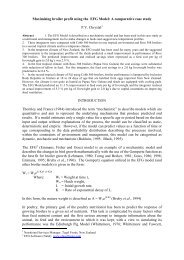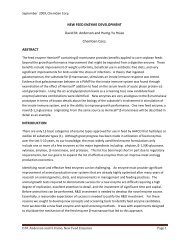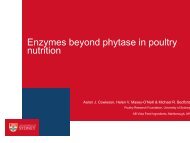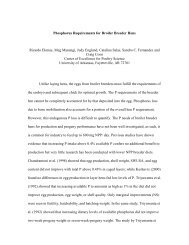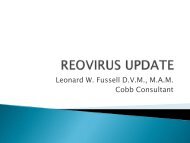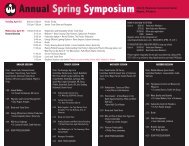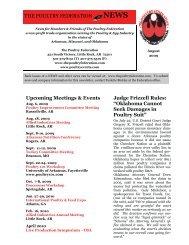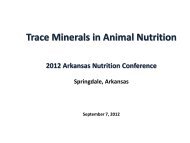Turkeys, Ascardia dissimilis, Fenbendazole and Performance
Turkeys, Ascardia dissimilis, Fenbendazole and Performance
Turkeys, Ascardia dissimilis, Fenbendazole and Performance
You also want an ePaper? Increase the reach of your titles
YUMPU automatically turns print PDFs into web optimized ePapers that Google loves.
Poultry Helminthiasis<br />
or, subtitle….<br />
Every bird gets the worm<br />
T.A. Yazwinski <strong>and</strong> C. A. Tucker<br />
Department of Animal Science<br />
University of Arkansas<br />
Fayetteville, Arkansas 72701<br />
yazwinsk@uark.edu
The Helminths of Poultry<br />
Bird Helminth<br />
“Young” chicken Ascaridia galli<br />
“Older” chicken Heterakis gallinarum<br />
Capillaria obsignata<br />
Raillietina cesticillus<br />
Choanotaenia<br />
infundibulum<br />
Any turkey Ascaridia <strong>dissimilis</strong>
Life Cycle of Ascaridia <strong>dissimilis</strong><br />
Immediately<br />
Fecund adults<br />
in gut contents<br />
(30 – 85mm)<br />
Few days<br />
Early adults in<br />
gut contents<br />
(30mm)<br />
Eggs in droppings<br />
1 week<br />
one month<br />
“Infective Egg”<br />
in litter<br />
2 nd larvae in gut<br />
contents (1mm)<br />
immediately<br />
2 weeks<br />
3rd 4<br />
larvae in gut<br />
contents or wall (4mm)<br />
1 week or ?<br />
th larvae in gut<br />
contents<br />
(10mm)
A. A 2001 study we did:<br />
3 isolates of A <strong>dissimilis</strong> (d 35-112 @ 100 E/b/d)<br />
3 treatment groups for each isolate<br />
• Infection <strong>and</strong> no FBZ<br />
• Infection <strong>and</strong> d 63-69 FBZ (in feed at 16 ppm)<br />
• Infection <strong>and</strong> d 63-69 & 91-97 FBZ (in feed at 16<br />
ppm)<br />
Constant feed measure & periodic weighbacks<br />
Periodic bird weights <strong>and</strong> parasite counts<br />
Three pens of birds with no infection
Geometric means for total worm<br />
burdens<br />
GM No. of nematodes<br />
400<br />
300<br />
200<br />
100<br />
0<br />
332<br />
256<br />
117<br />
141<br />
0<br />
35 63 69 91 97 119<br />
day of study<br />
* Gravid females present<br />
*<br />
*<br />
*<br />
128<br />
*<br />
No FBZ
Geometric means for total worm<br />
burdens<br />
GM No. of nematodes<br />
400<br />
300<br />
200<br />
100<br />
0<br />
332<br />
93<br />
87*<br />
100*<br />
3<br />
0<br />
35 63 69 91 97 119<br />
day of study<br />
* Gravid females present<br />
d 63-69 FBZ
Geometric means for total worm<br />
burdens<br />
GM No. of nematodes<br />
400<br />
300<br />
200<br />
100<br />
0<br />
332<br />
93 83<br />
3<br />
2<br />
0<br />
35 63 69 91 97 119<br />
day of study<br />
* Gravid females present<br />
d 63-69 & 91-97<br />
FBZ
<strong>Performance</strong> compared to uninfected<br />
controls – from day 35 to 63<br />
0.00%<br />
-0.50%<br />
-1.00%<br />
-1.50%<br />
-2.00%<br />
-2.50%<br />
-3.00%<br />
-3.50%<br />
-3.10% -3.10%<br />
ADG FE<br />
infected birds
<strong>Performance</strong> compared to uninfected<br />
controls – from day 63 to 91<br />
-6.70%<br />
-2.80%<br />
-8.70%<br />
ADG FE<br />
-4.60%<br />
infected birds<br />
infected, FBZ at d 63-<br />
69
<strong>Performance</strong> compared to uninfected<br />
controls – from day 91 to 119<br />
-3.40%<br />
-1.90%<br />
0.90%<br />
ADG FE<br />
-4.30%<br />
-10.10% -9.50%<br />
infected birds<br />
infected, FBZ at d 63-<br />
69<br />
infected, FBZ at d 63-<br />
69, FBZ at d 91-97
Final (day 119) bird weights compared to<br />
uninfected, control birds<br />
-3.20%<br />
-2.20%<br />
-1.30%<br />
infected<br />
infected, FBZ d 63-69<br />
infected, FBZ d 63-69,<br />
FBZ d 91-97
Some final statistics for the average bird/group<br />
d7-119 d7-119<br />
d119 Feed Lb feed<br />
Group lb wt. efficiency consumption<br />
No infections 30.4 2.76 81.8<br />
Infections & FBZ<br />
twice<br />
Infections & FBZ<br />
once<br />
30.0 2.88 84.1<br />
29.7 2.93 84.9<br />
Infections only 29.4 2.97 84.4
Evaluation of fenbendazole <strong>and</strong> albendazole<br />
in the treatment of turkey ascaridiasis as<br />
induced from isolates obtained from 4<br />
different sources in the USA<br />
Yazwinski, Tucker, Perkins,<br />
Manning & O’Berg<br />
Department of Animal Science<br />
University of Arkansas<br />
Fayetteville, AR
Materials & Methods<br />
1. Preparation of infective eggs:<br />
turkey intestines received from slaughter plant<br />
fecund females isolated & processed for eggs<br />
eggs incubated at room temperature (with air) for 51 days<br />
eggs refrigerated until used for inoculation<br />
2. Sources of infections:<br />
a. Indiana Purdue albendazole 10 MPK<br />
b. N. Carolina Prestage fenbendazole 16 PPM<br />
c. N. Carolina Goldsboro piperazine doesn’t matter<br />
d. Ohio Cooper albendazole & piperazine
3. Study Schedule:<br />
Materials & Methods<br />
bird day item<br />
0 arrival<br />
7 1,000 eggs/bird<br />
22 1,000 eggs/bird<br />
39 treat<br />
46 post<br />
4. Treatment groups for each isolate:<br />
GRP treatment<br />
1 control<br />
2 albendazole @ 5 MPK<br />
3 fenbendazole @ 5 MPK




